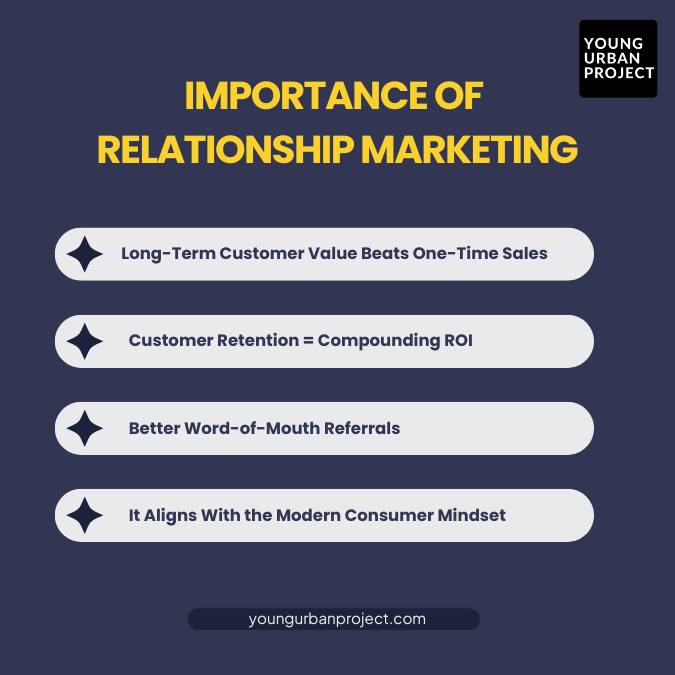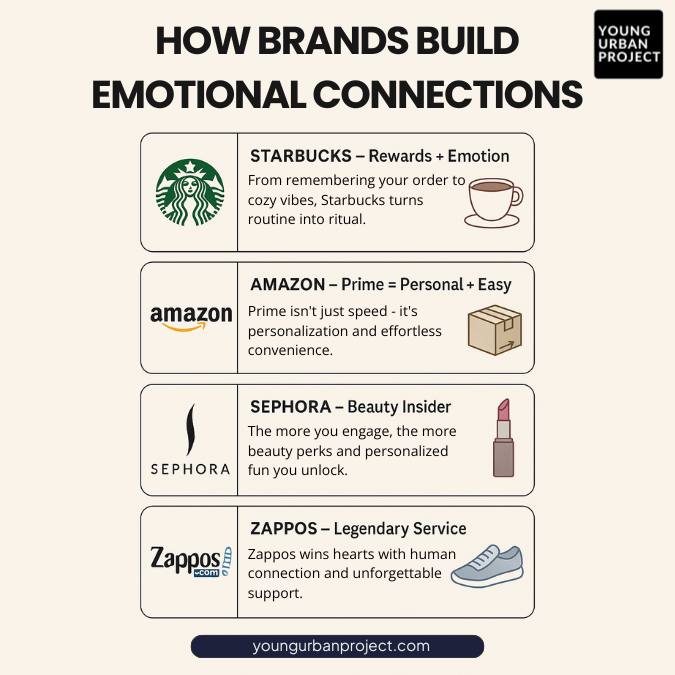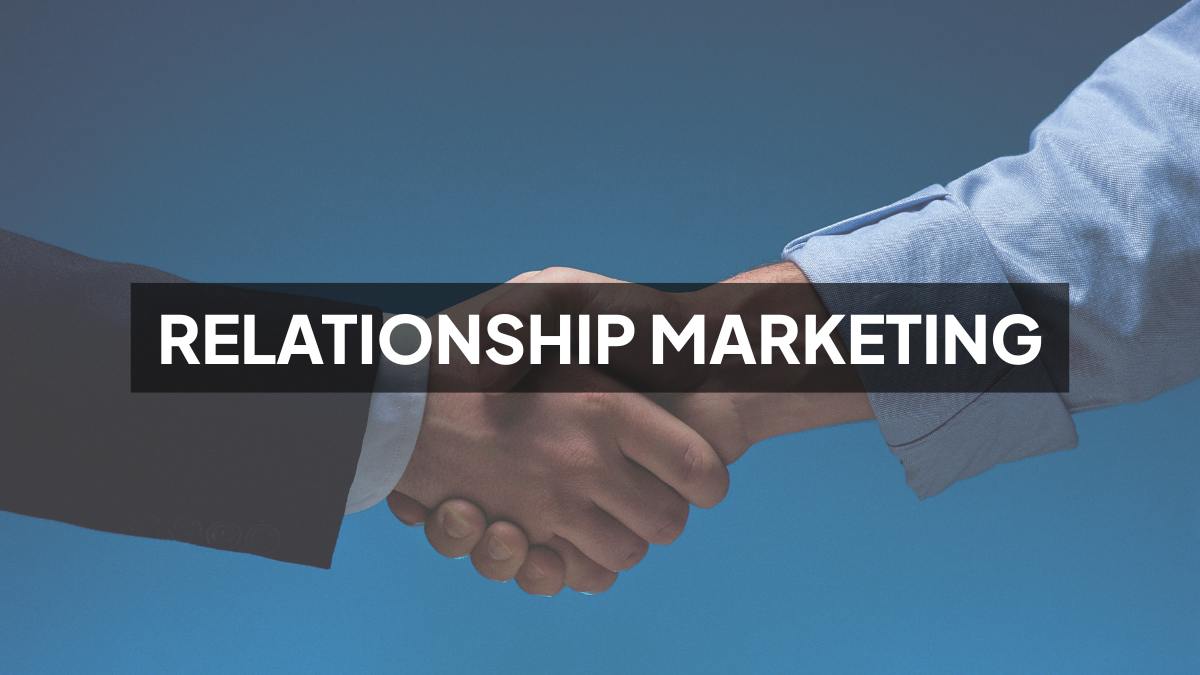Marketing isn’t what it used to be. Not too long ago, brands were laser-focused on one thing: the sale. The entire customer journey, from the first ad to the final purchase, was often designed around short-term gains. But in 2025, that’s just not enough.
Customers expect more now. They don’t just want a product, they want connection, value, and trust. That’s where relationship marketing comes in.
Table of Contents
Instead of asking, “How do we make this sale?”, relationship marketing asks, “How do we make sure this customer stays with us for the next five years?”
Think about brands like Apple, Starbucks, or Amazon. Their success isn’t just about flashy ads or clever slogans. It’s about how they make you feel. They create experiences that make you want to come back, not because of discounts, but because you feel seen, understood, and valued.
In this blog, we’ll break down what is relationship marketing, why it’s become essential in today’s market, the different strategies brands use, Real-life examples from companies doing it right, and how you can implement it in your own business, even if you’re just starting out. Let’s dive in.
What is Relationship Marketing?
Relationship marketing is a strategy focused on building long-term connections with your customers rather than just pushing one-time sales.
In simpler terms?
It’s like choosing to date your customers rather than just going on a one-night stand.
Instead of bombarding people with ads hoping they’ll buy once, you focus on consistently showing up for them, through valuable content, personalized communication, great customer service, and maybe the occasional thoughtful reward.
How it Differs from Traditional Marketing
| Aspect | Traditional Marketing | Relationship Marketing |
| Goal | Quick sales | Long-term loyalty |
| Approach | Broad and impersonal | Targeted and personalized |
| Focus | New customer acquisition | Customer retention and satisfaction |
| Communication | One-way (ads, promos) | Two-way (email, feedback, conversations) |
Also Read: Traditional marketing vs Digital marketing
A Quick Analogy
Imagine a local café where the barista remembers your name, knows your usual order, and occasionally gives you a free muffin just because. You feel good about going there, right?
Now contrast that with a place where you’re treated like just another number in the queue.
That’s the difference.
Relationship marketing turns a brand into something more than just a vendor. It becomes a trusted part of your life.
Why Relationship Marketing is Important in 2025
It’s not just a warm-and-fuzzy concept. Relationship marketing has real business value, and in 2025, it’s more critical than ever.

1. Long-Term Customer Value Beats One-Time Sales
It costs 5x more to acquire a new customer than to retain an existing one. That’s not new, but in a time when ad costs are rising and attention spans are shrinking, keeping the customers you already have is pure gold.
If someone has already bought from you once and had a good experience, there’s a solid chance they’ll buy again. But only if you nurture that relationship.
2. Customer Retention = Compounding ROI
Loyal customers spend more over time. According to research, increasing customer retention by just 5% can boost profits by 25–95% depending on your industry. That’s insane leverage.
Think of it like this:
You’re not starting from scratch with every customer. You’re stacking value, trust, and purchase intent.
3. Better Word-of-Mouth Referrals
People talk. And when they love your brand, they talk a lot.
Relationship marketing fuels that kind of organic word-of-mouth.
Let’s say a customer receives personalized support and an unexpected thank-you note. What are they more likely to do next? Probably screenshot it and post it to Instagram or rave about it in a group chat. That’s free, authentic marketing you can’t buy.
4. It Aligns With the Modern Consumer Mindset
Today’s consumers, especially Gen Z and younger millennials, are super value-conscious. But not just about price. They care about experience, personalization, transparency, and how a brand makes them feel.
Brands that understand this and build relationships accordingly will win.
Also Read: What is Guerrilla Marketing
Key Elements of Effective Relationship Marketing
You can’t just slap the word “loyalty” on a banner and call it a day. Real relationship marketing goes deeper.
Here are the non-negotiables:
1. Trust and Transparency
This is the foundation. If customers feel misled, whether it’s about pricing, product quality, or delivery timelines, they’re gone.
Being honest, even when it’s uncomfortable, builds lasting credibility. Own your mistakes. Over-communicate. Be human.
2. Consistent Communication (Not Just Salesy Stuff)
Don’t be the friend who only shows up when they need something.
Relationship marketing is about staying in touch even when you’re not selling.
Share updates, behind-the-scenes stories, helpful tips, or just a thoughtful check-in. Email, WhatsApp, social DMs, whatever channel feels most natural to your audience.
3. Personalization and Empathy
People don’t want to feel like just a “lead” in a CRM. They want to feel seen.
Use their name. Recommend things based on their past behavior. Understand their pain points and speak to them like a human, not a bot.
4. The Feedback Loop
Ask for feedback. Listen. Act on it.
It sounds basic, but so many brands miss this. Make it easy for customers to share what they think, and then actually do something with that input. It tells them their voice matters.
5. Delivering Value Beyond the Product
What else can you offer that improves your customer’s life? Maybe it’s educational content, community access, exclusive tips, or even curated entertainment.
Starbucks, for instance, doesn’t just sell coffee, it sells a vibe. The app offers games, rewards, personalization, and order-ahead convenience. That’s value beyond the cup.
Also Read: Green Marketing Examples
Types of Relationship Marketing Strategies
Rephrased: Different Ways to Build Strong Customer Relationships
Okay, let’s get tactical. Here are several proven ways brands build and nurture relationships:
1. Loyalty Programs and Reward Systems
Simple but powerful. Give people points, perks, or freebies for coming back. Make them feel rewarded for sticking around.
Example: Sephora’s Beauty Insider gives you birthday gifts, exclusive launches, and higher-tier rewards as you spend more. It’s addictive in a good way.
2. Email & SMS Marketing (Personalized, Not Spammy)
This is still one of the highest-ROI channels, but only if done right.
Send personalized recommendations, helpful content, and thoughtful reminders. Avoid the hard-sell every time. Make your emails feel like a friend checking in.
Tool tip: Platforms like Klaviyo, MailerLite, or Brevo make this kind of personalization easier than ever.
3. Customer Communities (Forums, Groups, Membership Spaces)
People love being part of something. Creating a space where customers can interact with each other and with your brand builds deeper loyalty.
Think: private Facebook groups, Discord servers, or even in-app forums.
Bonus: These communities also become goldmines for feedback and user-generated content.
4. After-Sales Support
How you treat customers after the sale often defines whether they’ll come back.
Quick, helpful, and friendly support can turn a frustrated user into a lifelong fan.
Brands like Zappos are legendary here. Their customer service isn’t just a department, it’s the heart of their brand.
5. Exclusive Member Benefits or Early Access
FOMO is real. Give your best customers first dibs on product drops, discounts, or events. Make them feel like insiders.
Think: “early access” to new collections, hidden features, or behind-the-scenes content.
Also Read: Create an AI Marketing Strategy
How Relationship Marketing Differs From Transaction-Based Selling
(a.k.a. Relationship Marketing vs Transactional Marketing)
Let’s get this out of the way: transactional marketing isn’t “bad.” It’s just limited.
There are times when it works, like flash sales, one-off purchases, or low-consideration products. But if you’re trying to build something sustainable, relationship marketing takes you further.
Here’s a quick side-by-side:
| Aspect | Relationship Marketing | Transactional Marketing |
| Focus | Ongoing customer relationship | One-time sale |
| Goal | Loyalty, retention, lifetime value | Quick revenue |
| Tone of communication | Personal, two-way | Generic, one-way |
| Example | “How can we help you succeed?” | “Buy now before the deal ends!” |
In short? Transactional marketing wants your money.
Relationship marketing wants your trust, and it plays the long game.

Enroll Now: Live Advanced Digital Marketing Course
Case Studies: How Brands Build Emotional Connections
Let’s look at a few real-life brands doing this well.

1. Starbucks: Rewards + Emotion
The Starbucks Rewards app isn’t just about free coffee.
It’s a personalized system that remembers your usual order, tracks stars (their version of points), offers games to win bonuses, and lets you order ahead. There’s a reason people go back. It feels smooth and rewarding.
Plus, there’s the vibe, the music, the names on cups, the cozy interiors. It’s a feeling, not just a transaction.
2. Amazon Prime = Personal + Easy
With Amazon Prime, it’s not just the fast shipping.
You get tailored product recommendations, saved preferences, super-fast support, and even early access to sales. Once you’re in the ecosystem, it becomes effortless to stay. That’s relationship marketing working silently in the background.
Also Read: Amazon Case Study
3. Sephora: Beauty Insider
Sephora’s loyalty program gives you perks based on how much you spend.
The more loyal you are, the better the rewards, from birthday gifts to exclusive events. Plus, they make shopping more fun with quizzes, tutorials, and curated picks.
4. Zappos: Legendary Service
Zappos became known not because they sold shoes, but because of how they treated people.
Stories of surprise upgrades, super-friendly phone reps, and even reps talking with customers for hours just to help them out, those stories still float around because they were real, and people remember that.
Also Read: What is Vibe Marketing?
Steps to Build Your Own Relationship Marketing Plan
This doesn’t need to be complicated. You can start small and build over time.
1. Know Your Customer
Seriously, know them. Not just their age and location. But what they value. What problems are they trying to solve? Why might they choose you over someone else?
You can do this through surveys, interviews, or just reading through reviews and support tickets.
2. Personalize Every Interaction
Use their name. Recommend things based on past behavior. If someone bought Product A, maybe they’d love Product B too.
You don’t need fancy tools at first. Just start with what you know.
3. Provide Value Between Purchases
If the only time they hear from you is when you want money, they’ll stop caring.
Send helpful emails. Drop tips. Share useful content. Think: “How can I help them win today?”
4. Choose the Right Channels
Where do your customers like to hear from you?
Some love email. Others prefer WhatsApp or Instagram DMs. Some want in-app updates. Don’t try to be everywhere, just be present where it counts.
5. Use Simple Tools to Track Relationships
You don’t need Salesforce on Day 1.
Start with something light like Zoho CRM, HubSpot (free version), or even just a well-managed spreadsheet. The point is to remember who your customers are and how they’ve interacted with you.
6. Ask for Feedback, Then Act on It
Don’t just say “Let us know what you think.” Mean it.
Ask for honest input. And when you do make changes, tell them: “You asked for this. We listened.”
That simple loop builds trust faster than almost anything.
Also Read: Top Marketing Planning Software Tools
Top Advantages of Relationship Marketing for Businesses
If you’re wondering whether all this effort is worth it, here’s what you get in return:
1. More Loyal Customers
People stick around longer when they feel valued. That means more repeat purchases and less chasing new customers all the time.
2. Lower Marketing Costs
When someone already trusts your brand, you don’t need to work so hard (or spend as much) to convince them again.
3. Better Word of Mouth
Happy customers talk. They refer friends. They post online. And that kind of marketing doesn’t cost you a dime.
4. Higher Customer Lifetime Value
Over time, loyal customers often spend more than first-time buyers. You’re building a longer runway for growth.
5. Easier Upsells and Cross-Sells
Once people trust you, they’re more open to trying your other products or services. You don’t have to push; you just suggest.
Also Read: The Five Marketing Concepts
Challenges of Relationship Marketing (and What To Do About Them)
Let’s be honest, it’s not always easy. Here are a few common roadblocks:
1. Personalizing at Scale
As your audience grows, it gets harder to keep things feeling personal. But tools like email automation or segmenting your audience can help.
Just remember: even small touches (like using a first name) go a long way.
2. It Takes Time and Resources
Building relationships isn’t “set it and forget it.” It needs a bit of time, effort, and sometimes a team.
Start small. One good follow-up email is better than a dozen bad ones.
3. People Expect Fast Replies
The bar is higher now. Customers expect quick answers, and if you’re slow, they might bounce.
You can use things like chatbots, auto-responders, or even just setting clear response times to manage this better.
Also Read: Top AI Email Writers
What’s Next for Relationship Marketing?
Things keep evolving. Here’s where it looks like we’re heading:
1. AI-Powered Personalization
Tools like ChatGPT, Klaviyo AI, and even Shopify’s smart recommendations are making it easier to personalize messages, offers, and content based on user behavior, almost in real time.
2. Community-First Brands
We’re seeing more brands grow not by ads, but by building communities, Discord groups, niche forums, and private IG chats. It’s not about having the most followers, but the most engaged ones.
3. Influencers Who Actually Use the Product
Influencer marketing isn’t going away, but people are tuning out the fake stuff.
Relationship-driven influencer campaigns, where creators are actual fans of the brand, will feel more real and more effective.
4. Predictive Tools That Know What Customers Want Before They Ask
This sounds futuristic, but it’s already happening. Brands are using customer behavior to predict what someone might need next and offer it at the right time. That’s not annoying, that’s helpful.
Also Read: What Is Marketing Management?
Final Thoughts: Build Relationships, Not Just Revenue
Here’s the thing, people want to buy from brands they trust. Ones that see them, hear them, and treat them like more than a transaction.
You don’t need a massive budget to do this.
You just need to start thinking differently.
Start with one small thing:
→ Send a thank-you message after a purchase.
→ Ask a customer how their experience was.
→ Share something helpful, without asking for anything in return.
Small gestures build trust. Trust builds loyalty. And loyalty builds businesses.
FAQs: Relationship Marketing
Q1. What is relationship marketing in simple terms?
It’s a way of doing marketing that focuses on building long-term connections with your customers instead of just chasing a quick sale.
Q2. How is relationship marketing different from traditional marketing?
Traditional marketing is about getting attention and closing deals. Relationship marketing is about keeping people around and turning them into loyal fans.
Q3. What are the key elements of relationship marketing?
Trust, good communication, personalization, providing value, and listening to customer feedback.
Q4. Which industries benefit most from relationship marketing?
E-commerce, SaaS, retail, hospitality, coaching, pretty much any business that wants people to come back again and again.
Q5. Can small businesses use relationship marketing?
Absolutely. In fact, small brands often do it better, because they’re closer to their customers and can make things feel more personal.
Q6. What tools can help?
CRMs like Zoho, email tools like MailerLite or Klaviyo, feedback platforms like Typeform, and community tools like Facebook Groups or Slack.

